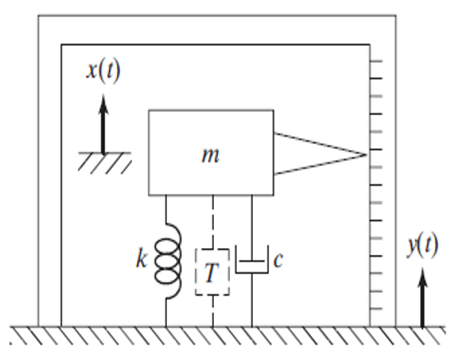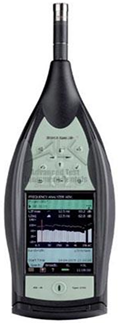Unit 5
Q.1 Classify vibration measuring instruments
A1) Vibration measuring instruments are classified as below:
I. Contact type: These types of vibration measuring instruments are in direct contact with the vibration machines. These instruments are compact in size. e.g. Accelerometer
II. Non-contact type: These types of vibration measuring instruments are used when it is very difficult to use the contact type vibration measuring instruments. These types of instruments also small in size.
2. CLASSIFICATION BASED ON DISPLAY METHOD
I. Indicating type: In these instruments, the measured data are displayed on the display unit of the instruments.
II. Recording type: These instruments are used to display and also to record the data for future analysis. e.g. FFT analyzer
3. CLASSIFICATION BASED ON TIME BASE MEASUREMENT
I. Indicating type: In these instruments, the measured data are displayed on the display unit of the instruments.
II. Recording type: These instruments are used to display and also to record the data for future analysis. e.g. FFT analyzer
4. CLASSIFICATION BASED ON POWER SOURCE
I. Active system: In these instruments, source of power is required to operate the instruments for vibration measurement. e.g. FFT analyzer
II. Passive system: These instruments do not require any outside source of power to operate the instruments. They are compact, handy and battery operated. e.g. Frahm’s tachometer
Q.2 Write a note on vibration pick up
A2)

1. Stylus Recording Instrument
2. Seismic Instrument or Seismometer or Vibration Pickup
3. Optical Recording Instrument
4. Simple Potentiometer
5. Capacitance Pickup
6. Mutual Inductance Pickup

Q.3 Explain electrodynamic exciter with its advantages and disadvantages.
A3)

Advantages
Disadvantages
It has great mass and volume with respect to the amplitudes of the generating exciting force.
Q.4 Explain FFT spectrum Analyzer and give its types.
A4) FFT SPECTRUM ANALYZER
Types of FFT Analyzer
- Both measurement and analysis is done in same instrument.
- Data can be collected from actual field for analysis.

2. Computer Based FFT Analyzer

3. Single Channel FFT Analyzer

4. Two Channel FFT Analyzer
Simultaneously 2 input can be taken or connected i.e. accelerometer and microphone can be connected at the same time or same type of data can be measure for different points.
5. Multi-Channel FFT Analyzer
Q.5 Explain Time Domain and Frequency Domain Analysis.
A5)
The time domain analysis uses acceleration-time plot of the signal.
The damages such as broken teeth in gears can be identified easily from the acceleration-time plot of the casing of the gear box.

2. Frequency Domain Analysis
The frequency domain analysis or frequency spectrum is the plot of amplitude of vibration versus frequency. It is converted from time domain signal by using FFT spectrum analyzer.

Q.6 Explain the analysis of vibration spectrum
A6) When machine starts developing faults, shape of frequency spectrum changes accordingly. By comparing frequency spectrum of machine when it is in good condition, with the frequency spectrum when it is in damaged condition, the nature and location of fault can be easily detected.
Consider a machine element or Component shown in fig below.

Each element in machine has identifiable frequency, therefore the change in the spectrum at given frequency can be attributed directly to that corresponding machine component.
The peaks in the frequency spectrum are related to various components as shown in fig (b)

By comparing the frequency spectrum of machine when it is in good condition, fig (b), and the frequency spectrum of machine when it is in bad condition, fig (c), the analysis is done and faults are found from the machine component.
The analytical equations are available to find the fault frequencies of standard components like: bearings, gear, boxes, motors, pumps, fans, etc.
Q.7 What is vibration control? Give methods of vibration control.
A7) Vibration Control
Whenever the natural frequency of a machine or a structure coincides with the frequency of the external excitation, the resonance occurs which leads to the excessive deflection and failure of system. By vibration control the unwanted harmful vibrations can be reduced to an acceptable limit.
The various methods of vibration control aim at modifying the source or the system.
The various methods of vibration control are:
2. Source Isolation
Source provides the energy to maintain vibration. sources of vibration could be of several types
In source Isolation, the transmission path of vibration between source and the system is modified to protect the system.
3. System Modification
A large number of methods exist in system modification including detuning, decoupling, using additive damping treatments ( constrained and unconstrained ), stiffeners and massive blocks (as foundation).
While designing a system, care should be taken that, its natural frequencies lie outside the excitation frequency range.
4. Active Feedback Control
In this method, a signal generated by the response is suitably processes to produce a desired amplification of the phase change in the signal. This processed signal drives an actuator which in turn provides an additional excitation.
This excitation is then fed back to the vibratory system which shifts the excitation frequency away from its natural frequencies.

Q.8 Write a note on semi-active vibration isolation.
A8) Semi-Active isolation system uses dampers with fluids which changes its viscosity by application of electric or magnetic fluids.
Fluid which changes its viscosity by application of electric fluid are called as Electro-Rheological Fluids. Dampers which uses electro-rheological fluids are called as electro-rheological dampers.
Fluid which changes its viscosity by application of magnetic fluid are called as Magneto-Rheological Fluids. Dampers which uses magneto-rheological fluids are called as magneto-rheological dampers.
A typical use of ER/MR fluid for vibration isolation is shown in fig.

The vibration isolator consists of a parallel combination of a helical spring and a piston cylinder with ER or MR fluid. It has been observed that with suitable combination of particle concentration, carrier fluid and the strength of electric or magnetic field using high voltage amplifier, the damping characteristics of the dashpot can be varied over a wide range.
Q.9 Explain vibration control by control of natural frequencies.
A9) When the frequency of external excitation coincides with natural frequency of the system, the resonance occurs. In resonance, the amplitude of vibration is maximum which can lead to system failure.
In most of the cases, the excitation frequency cannot be controlled. In such cases, it is necessary to change the natural frequency of system to avoid the resonance.
The natural frequency of the system depends on the mass and stiffness of the system. Therefore, by changing one of the parameter, the natural frequency can be changed.
In many applications, mass cannot be changed easily, since it is determined by the functional requirement of the system. Therefore, in such cases, stiffness is the parameter that is changed to change the natural frequency.
It can be done by changing material or number and location of support points.
Q.10 For finding vibration parameters of a machine running at 260 rpm, a seismic instrument is used. The natural frequency of the instrument is 7 Hz and the recorded displacement is 6 mm. Determine the displacement, velocity and acceleration of the vibrating machine assuming no damping.
A10)
Speed of machine 
Excitation frequency, 
Natural frequency of instrument, 
Amplitude of vibration, 
Damping ratio, 
Natural circular frequency of instrument is,

The steady relative amplitude is,




Displacement of vibrating machine is 9.66mm
The velocity of vibrating machine is,


The acceleration of vibrating machine is,


Q.11 Vibration of a machine tool structure subjected to an excitation at 2 Hz is measured using a seismic instrument whose natural frequency is 5 Hz. The relative displacement is shown is 0.4 micrometers. Determine the acceleration of the machine tool structure.
A11)  ,
,
Natural frequency of system is,


And, 
But, 
The study state relative amplitude is,





The acceleration of vibrating machine is,
